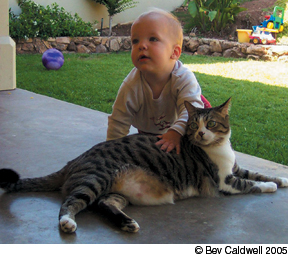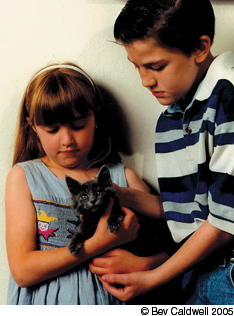Obviously, you know that a pet is not a toy to be played with and then discarded at your whim. And this is an important lesson to teach your child before bringing home a new cat or kitten to join the family.

288
Even at an early age, a child can learn so much from a pet: how to give and accept love, and how to make friends and become sensitive to the needs of others. In addition, cats and children can form a lifelong bond that surpasses that of even some close human relationships. But in order for this to happen, children first have to learn how to handle a pet gently and with respect.
No Surprises, Please
I would never just bring home a cat or kitten for a child, says Cori White, MA, behavior specialist in the Horne Street Elementary School in Dover, New Hampshire. There has to be a lot of preparation for a pet, says Ms. White, to ensure that the child wont hurt the cat – and that the cat wont hurt the child.
Just as you would when expecting a new baby, you need to tell your child what it will be like with a new cat. Give your child time to get ready. Start a countdown, explains Ms. White. I would say, for example, In three weeks well have a new kitty, and then, In two weeks the kitty is coming, and so on.
What Your Child Needs to Know
Your child will learn from watching how you and other family treat your cat. If you are patient and affectionate, your child will learn those behaviors. If you are responsible and caring when you discipline a new kitten, chances are good that your son or daughter will act the same way.
Before the cat comes home, you should practice on some stuffed animals, says Ms. White. Show the child how to hold the pet – which is the right way and which way is too tight. Demonstrate how to pat a cat gently and the things to do to avoid being scratched. Teach your child not to be too rough with an animal. This will not only protect your new cat, but may positively influence your childs treatment of other children. In other words, you are simply teaching your child respect for others.
Show your child where the cat will sleep, eat and use the litter box. You should set limits with your child before he or she even sets eyes on the new family member. If the cat will stay indoors, make that a rule for your child to follow. If the childs friends are not allowed to touch the small kitten, make that clear to your child beforehand. If you dont want anyone to feed the cat scraps from the table, tell your child now – before the cat comes home.
Reading a book about cats and taking care of a pet is a good way to introduce your tot to what will be expected of him.
A very important concept to get across to your child is the notion of privacy. Cats – especially kittens – need time to rest and be alone. Tell your child that sometimes the cat needs to sleep and have some quiet time, just as a human baby does.

234
Supervision Is Key
When you finally get the kitten home, dont allow your child to be alone with the newcomer. Taking care of a pet is a learned skill, says Ms. White. Show your child how to pick up the kitten and put her down. Go through the kittens routine that you spoke about before the new pet arrived. Include your child in all the aspects of the kittens care – feeding, grooming, playing and teaching how to use the litter box. Just make sure, says Ms. White, that you supervise the child and kitten at the beginning.
Depending on your childs age and skills, it may be wise to establish that your child knows how to interact responsibly and humanely before giving him or her permission to play with the cat.
If you find that your child is too rough, be patient and concretely demonstrate what you mean by appropriate behavior. No doubt there will be some scratches and nips. Explain what is most likely going to provoke a cat or kitten – and do your best to show your child how to avoid getting hurt. Its really important to explain that a cat doesnt scratch or bite to be mean, but to protect itself. Also explain how cats sometimes scratch and bite when they play (and why its best to play in ways that dont encourage that type of feline behavior).
In no way should you allow your child to hit a cat if the animal misbehaves. If your child is abusive to an animal – whether the abuse is intentional or not – its crucial to talk to your child about how his behavior can affect the pet, according to the National Association for the Advancement of Humane Education. Following an unkind act, urge your child to reach out and comfort the cat.
If there is continued abuse or cruelty toward the pet, you must consider removing the pet from the home. And you should consider seeking professional counseling for your child because pet cruelty can be a sign of psychological problems that need early intervention.
Lower Your Expectations
Dont expect your child to feed, groom or (especially) clean the litter box on any regular basis before the age of 12. Despite the undying promises to take care of the cat, a young child usually isnt ready for such a responsibility. But to prepare your child for eventual pet chores, include him or her as you take care of the new cat.
Show your child how much food to put in Kittys bowl. While you hold your cat, encourage your kid to help comb and brush Kitty. And dont make faces when you clean the litter box; demonstrate to your child that its just another routine chore and essential aspect of responsible pet care.
Most importantly – use this first experience to show your child the wonder of a cats love. Chances are that your child will go on to love many more cats in his or her lifetime, but there will always be a special spot in his or her heart for that first childhood kitten.



